Related Research Articles

Robert I, popularly known as Robert the Bruce, was King of Scots from 1306 to his death in 1329. One of the most renowned warriors of his generation, Robert eventually led Scotland during the First War of Scottish Independence against England. He fought successfully during his reign to regain Scotland's place as an independent kingdom and is now revered in Scotland as a national hero.

The Wars of Scottish Independence were a series of military campaigns fought between the Kingdom of Scotland and the Kingdom of England in the late 13th and early 14th centuries.
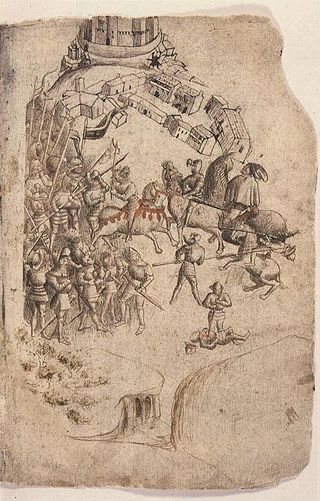
The Battle of Bannockburn was fought on 23–24 June 1314, between the army of Robert the Bruce, King of Scots, and the army of King Edward II of England, during the First War of Scottish Independence. It was decisive victory for Robert Bruce and formed a major turning point in the war, which ended 14 years later with the de jure restoration of Scottish independence under the Treaty of Edinburgh–Northampton. For this reason, the Battle of Bannockburn is widely considered a landmark moment in Scottish history.
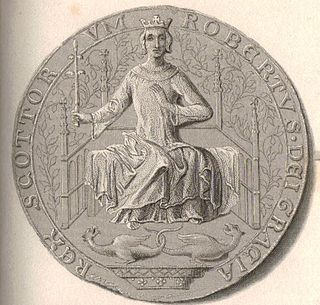
Robert II was King of Scots from 1371 to his death in 1390. The son of Walter Stewart, 6th High Steward of Scotland, and Marjorie, daughter of King Robert the Bruce, he was the first monarch of the House of Stewart. Upon the death of his uncle David II, Robert succeeded to the throne.
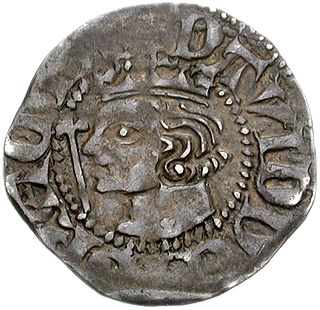
David II was King of Scots from 1329 until his death in 1371. Upon the death of his father, Robert the Bruce, David succeeded to the throne at the age of five, and was crowned at Scone in November 1331, becoming the first Scottish monarch to be anointed at their coronation. During his childhood Scotland was governed by a series of guardians, and Edward III of England sought to take advantage of David's minority by supporting an invasion of Scotland by Edward Balliol, beginning the Second War of Scottish Independence. Following the English victory at the Battle of Halidon Hill in 1333, David, his queen and the rump of his government were evacuated to France, where he remained in exile until it was safe for him to return to Scotland in 1341.
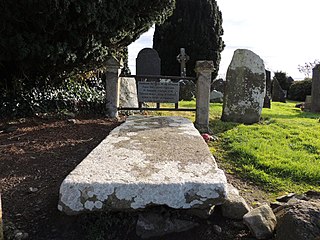
Edward Bruce, Earl of Carrick, was a younger brother of Robert the Bruce, King of Scots. He supported his brother in the 1306–1314 struggle for the Scottish crown, then pursued his own claims in Ireland. Proclaimed High King of Ireland in 1315 and crowned in 1316, he was eventually defeated and killed by Anglo-Irish forces of the Lordship of Ireland at the Battle of Faughart in County Louth.

The Battle of Neville's Cross took place during the Second War of Scottish Independence on 17 October 1346, half a mile to the west of Durham, England. An invading Scottish army of 12,000 led by King David II was defeated with heavy loss by an English army of approximately 6,000–7,000 men led by Ralph Neville, Lord Neville. The battle was named after an Anglo-Saxon stone cross that stood on the hill where the Scots made their stand. After the victory, Neville paid to have a new cross erected to commemorate the day.
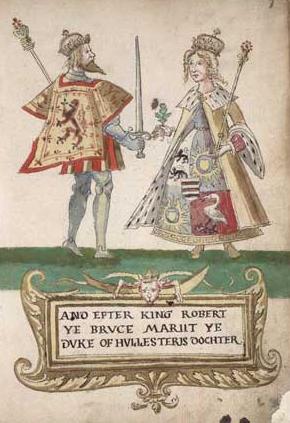
Elizabeth de Burgh was the second wife and the only queen consort of King Robert the Bruce. Elizabeth was born sometime around 1289, probably in what is now County Down or County Antrim in Ulster, the northern province in Ireland. She was the daughter of one of the most powerful Norman nobles in the Lordship of Ireland at that time, Richard Óg de Burgh, the 2nd Earl of Ulster, a member of the noble dynasty, the House of Burgh and a close friend and ally to King Edward I of England.

Earl of Carrick is the title applied to the ruler of Carrick, subsequently part of the Peerage of Scotland. The position came to be strongly associated with the Scottish crown when Robert the Bruce, who had inherited it from his maternal kin, became King of the Scots in the early 14th century. Since the 15th century, the title of Earl of Carrick has automatically been held by the heir apparent to the throne, thus the current holder of the title is Prince William, Duke of Rothesay.

Marjorie Bruce or Marjorie de Brus was the eldest daughter of Robert the Bruce, King of Scots, and the only child born of his first marriage with Isabella of Mar.

The Guardians of Scotland were regents who governed the Kingdom of Scotland from 1286 until 1292 and from 1296 until 1306. During the many years of minority in Scotland's subsequent history, there were many guardians of Scotland and the post was a significant constitutional feature in the course of development for politics in the country.
Margaret Drummond, known also by her first married name as Margaret Logie, was the second queen of David II of Scotland and a daughter of Sir Malcolm de Drummond, 10th Thane of Lennox by his wife Margaret Graham, Countess of Menteith.
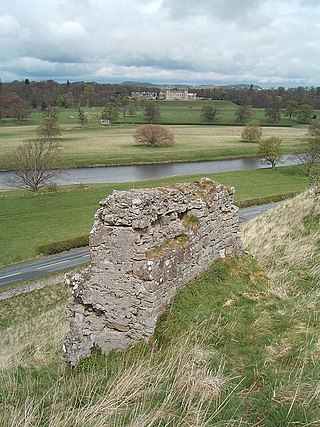
Roxburgh Castle is a ruined royal castle that overlooks the junction of the rivers Tweed and Teviot, in the Borders region of Scotland. The town and castle developed into the royal burgh of Roxburgh, which the Scots destroyed along with the castle after capturing it in 1460. Today the ruins stand in the grounds of Floors Castle, the seat of the Duke of Roxburghe, across the river from Kelso.

Sir Robert Keith was a Scottish nobleman and a hereditary Great Marischal of Scotland.
Christian or Christina Bruce, also known as Christian or Christina de Brus, was a daughter of Marjorie, Countess of Carrick, and her husband, Robert de Brus, jure uxoris Earl of Carrick, as well as a sister of Robert the Bruce, King of Scots. It is presumed that she and her siblings were born at Turnberry Castle in Carrick.

Edward Balliol or Edward de Balliol was a claimant to the Scottish throne during the Second War of Scottish Independence. With English help, he ruled parts of the kingdom from 1332 to 1356.
The Second War of Scottish Independence broke out in 1332 when Edward Balliol led an English-backed invasion of Scotland. Balliol, the son of a former Scottish king, was attempting to make good his claim to the Scottish throne. He was opposed by Scots loyal to the occupant of the throne, eight-year-old David II. At the Battle of Dupplin Moor Balliol's force defeated a Scottish army ten times their size and Balliol was crowned king. Within three months David's partisans had regrouped and forced Balliol out of Scotland. He appealed to the English king, Edward III, who invaded Scotland in 1333 and besieged the important trading town of Berwick. A large Scottish army attempted to relieve it but was heavily defeated at the Battle of Halidon Hill. Balliol established his authority over most of Scotland, ceded to England the eight counties of south-east Scotland and did homage to Edward for the rest of the country as a fief.
The Battle of Loch Ryan was a battle fought on 9/10 February 1307 during the Scottish Wars of Independence near Stranraer on Loch Ryan, Galloway, Scotland.
Sir Christopher Seton (1278–1306), also known as Christopher de Seton, was a 13th-century noble, who held lands in England and Scotland. He was a supporter of Robert the Bruce and obtained Robert's sister's hand in marriage. Present during the killing of John Comyn, Lord of Badenoch at Greyfriars Church, Dumfries, he also killed Sir Robert Comyn, who had rushed to Badenoch's aid. Seton was captured at Loch Doon Castle and executed at Dumfries in 1306.
The sieges of Berwick were the Scottish capture of the town of Berwick-upon-Tweed on 6 November 1355 and their subsequent unsuccessful siege of Berwick Castle, and the English siege and recapture of the town in January 1356. In 1355 the Second War of Scottish Independence had been underway for over 22 years. After a period of quiescence the Scots, encouraged by the French who were fighting the English in the Hundred Years' War, assembled an army on the border. In September a truce was agreed and much of the English army left the border area to join King Edward III's campaign in France.
References
- Maxwell, Herbert, ed. (1913). The Chronicle of Lanercost, 1272–1346 : Translated, with notes. Glasgow: J. Maclehose and sons. pp. 330. OCLC 457526322.
- Penman, Michael (2018). Robert the Bruce: King of the Scots. New Haven: Yale University Press. ISBN 978-0300240313.